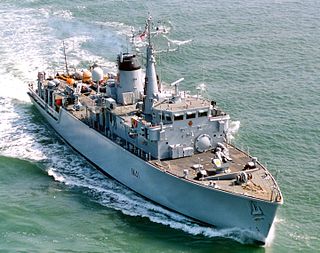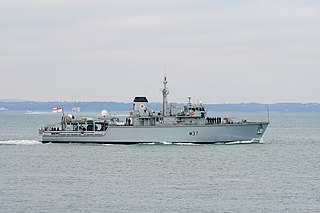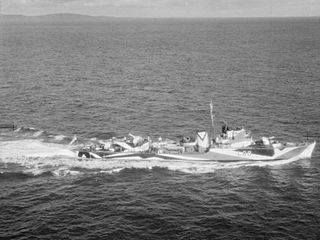Related Research Articles
Five ships of the Royal Navy have been named HMS Serapis, after the god Serapis of Hellenistic Egypt.
Seven Royal Navy ships have been named HMS Duncan, after Admiral Adam Duncan, 1st Viscount Duncan of Camperdown, hero of the Battle of Camperdown.
Three ships of the Royal Navy have been named HMS Quorn, all named after the Quorn Hunt.

The Hunt class is a class of thirteen mine countermeasure vessels of the Royal Navy. As built, they combined the separate roles of the traditional minesweeper and that of the active minehunter in one hull, but later modifications saw the removal of mine-sweeping equipment. They have a secondary role as offshore patrol vessels.
Three ships of the Royal Navy have been named HMS Atherstone after the town of Atherstone in Warwickshire, or after its hunt:
Three ships of the Royal Navy have been named HMS Brocklesby after the Brocklesby hunt:
Three ships of the Royal Navy have been named HMS Cattistock after the Cattistock hunt:
Three ships of the Royal Navy have been named HMS Cottesmore after the Cottesmore hunt:
Two ships of the Royal Navy have been named HMS Middleton after the Middleton hunt:
Two ships of the Royal Navy have been named HMS Dulverton after the Dulverton hunt:
Two ships of the Royal Navy have been named HMS Ledbury, named after Ledbury Hunt, Herefordshire:

HMS Chiddingfold is a Hunt-class mine countermeasures vessel of Britain's Royal Navy. She was launched in October 1983 by her sponsor, Lady Anne Kennon, and formally entered the service of the Royal Navy in October 1984. Chiddingfold is a minehunter, and her purpose is to find and destroy mines, not only in a time of war but also in peacetime. There are about a quarter of a million mines still active from the Second World War alone and they pose a major threat to both military and civilian ships. Chiddingfold is able to enter some types of minefields without magnetic mines detonating because she is made of glass-reinforced plastic, and all fixtures within the ship are made of non-ferrous metals, keeping the ship's magnetic signature to the bare minimum.
Two ships of the Royal Navy have borne the name HMS Exmoor, after the Exmoor fox hunt:
The following ships of the Indian Navy have been named Ganga:
Two ships of the Royal Navy have been named HMS Blackmore, named after Blackmore, Essex:

HMS Chiddingfold (L31) was a Type II Hunt-class destroyer of the Royal Navy. She was leased to the Indian Navy in 1952 where she served as INS Ganga (D94).

HMS Lamerton was a Type II Hunt-class destroyer of the Royal Navy. She was sold to the Indian Navy in 1952, where she served as INS Gomati.